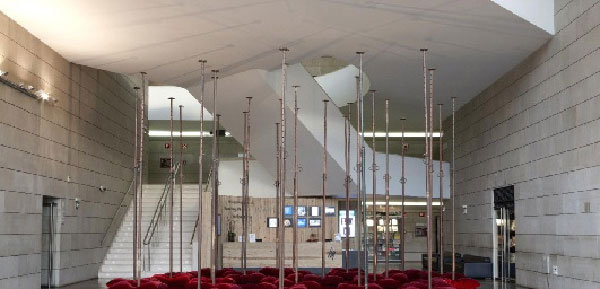Natividad Navalon
dal 17/12/2009 al 20/2/2010
Segnalato da
IVAM Institut Valencia' d'Art Modern
17/12/2009
Natividad Navalon
IVAM Instituto Valenciano de Arte Moderno, Valencia
My Mother's Suitcase

The exhibition La maleta de mi madre (My Mother’s Suitcase), which tells a story in five rooms, describes the relationship between mother and daughter as an interplay between experience and a new beginning. At a certain age all children experience the responsibility that is passed on to them by the mother.
In El sueño de vivir (The Dream of Living) one is surrounded by the mother’s objects, which convey an intense feeling of well-being, warmth, security and trust. In art, hair is often used as a sign of intimacy and femininity. In Navalón’s work Sentir el calor de mi morada (Feeling the Warmth of My Dwelling Place), long strands of hair lie on the mother’s white bed, spilling out from under the pillow.
The first years in a little girl’s life are thus the most important in her development into a woman. As she grows up she likes having her mother’s objects and clothes around her.
In her sculpture Buscando esa mujer (Searching For That Woman) is an oversized handbag placed in the room. A girl in a short dress is bending over into the bag, apparently in order to look through what is inside it. Thus, in her search for unfulfilled longings and wishes, she immerses herself in the mother’s personality and identifies with her. In this work, in the establishment of the relationship between mother and daughter the latter still plays a subordinate role.
The installation De madres a hijas (From Mothers to Daughters) shows twenty-eight tall chairs made of metal placed in pairs opposite each other. A cloth connects each pair of chairs and partly falls on the floor. The cloth could stand for an uncut umbilical cord, though leading to the separation between mother and daughter. The child has grown up and sits facing the mother, with their eyes at the same height, in a position of a dialogue or a confrontation. The fact that they are facing each other symbolises the equal value of mother and daughter.
The installation La maleta de mi madre (My Mother’s Suitcase) consists of twelve suitcases, made of bronze and felt, which are set against the wall. On the wall the following words can be read:
"Memories, indecisions, dreams and failures, advice, presences, desires, illusions, doubts and disasters, sadness, "mummy, where do I put this?" Alone now, she was no longer a daughter, she was only a mother, she had to pass on the legacy that all mothers have the privilege of passing on to their daughters."
The suitcases symbolically contain everything that defines the mother, her clothing, her smell, the memory of forgotten times and the desire to see everything once again with one’s mind’s eye. Life is understood as a transition in which the child lives through all the stages of the mother and takes over her active role with the suitcase.
The sculpture Tiempo de arroz y sal (Rice and Salt Time) consists of a lead boat about fourteen metres long and nine metres wide, which is full of rolled-up white towels. The boat symbolises a woman’s journey through life. The towels stand for purity, innocence, virginity, tradition and cleanliness. The young woman sets off into the future and repeats her mother’s life cycle in her own way. She continues along the path on her own, and the mother as an opponent is left behind. The cutting of the umbilical cord is completed. The boat symbolises this parting and the move to a new life.
Navalón concludes her journey through a woman’s life with the installation El paso del legado (Passing On the Legacy) It consists of seven dark blue pools of water, each one ten centimetres deep and fifteen metres long. At the end of each stretch of water there is a small white bench on which a white towel has been placed. The mother has disappeared into the water, and has given her body over to nature. She is no more. A meditating atmosphere fills this room whith a sense of tranquility and prayer. In a far corner a fibreglass sculpture of a little girl, tries pushing her body through the concrete wall. A new life cycle is about to begin with new mothers and daughters.
In art, water represents the flow of life which leads to death, just as the river leads to the sea. Water expresses the hope for a peaceful death, when the gentle wave washes over imperceptibly from one life into the other.
The soul outlasts all cycles and processes, it lives on with us without any effort on our part. We carry it within us, surrounded by the endlessness of existence.
IVAM Institut Valencià d’Art Modern
Centro Julio Gonzalez - Galería 3
Guillem de Castro, 118 - 46003 Valencia
Opening Hours:
Tuesday to Sunday: 10 am to 8 pm
Monday: closed
General entrance: 2,00
Students / Student card: 1,00
Retired people: Free entrance



